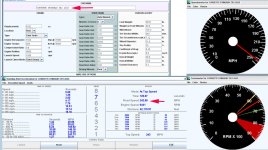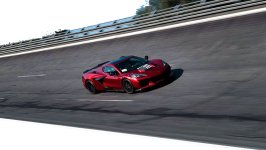teamzr1
Supporting vendor
GM ran the new 2025 ZR1 at the TP track in Papenburg, Germany where it averaged 233 MPH.
Driving the all new 2025 Corvette ZR1 was GM President Mark Reuss who said he had confidence in the car’s ability thanks to the people who helped prepped the car for the run, but also the engineering that is behind it as well.
Mark says he left it in Sport Mode, and we also see from the data telemetry that the car was in 6th gear with the RPM pegged at the 8,000 red line!
Chevrolet does their top speed runs in two directions and then averages the difference.
Their first run netted a speed of 233.08 while their second run came in at 233.50 MPH.
Chevrolet says that the 233 MPH top speed run is unrivalled by any current production car priced under $1 million, and it wasn’t something that was achieved in a specially prepped Corvette.
This ZR1 had the standard chassis and aero package, standard spoiler, carbon fiber ground effects, Michelin Pilot Sport 4S Tires and aluminum wheels.
During the testing, five engineers and both ZR1 development cars onsite exceeded 230 mph across multiple runs.
Setting the top-speed record in the Corvette ZR1 is a true triumph for Corvette and for Chevrolet, and also an exhilarating, surreal experience for me personally,” said Reuss. “With the current generation’s switch to mid-engine, we knew the outstanding performance and balance made this a real possibility.
To go over there and get it done is a testament to the power of ZR1, and to the incredibly talented team that developed and built it.”
Interesting I was not too far off as to top end using my simulator, that would be I not knowing what the weather and elevation at that racetrack


Driving the all new 2025 Corvette ZR1 was GM President Mark Reuss who said he had confidence in the car’s ability thanks to the people who helped prepped the car for the run, but also the engineering that is behind it as well.
Mark says he left it in Sport Mode, and we also see from the data telemetry that the car was in 6th gear with the RPM pegged at the 8,000 red line!
Chevrolet does their top speed runs in two directions and then averages the difference.
Their first run netted a speed of 233.08 while their second run came in at 233.50 MPH.
Chevrolet says that the 233 MPH top speed run is unrivalled by any current production car priced under $1 million, and it wasn’t something that was achieved in a specially prepped Corvette.
This ZR1 had the standard chassis and aero package, standard spoiler, carbon fiber ground effects, Michelin Pilot Sport 4S Tires and aluminum wheels.
During the testing, five engineers and both ZR1 development cars onsite exceeded 230 mph across multiple runs.
Setting the top-speed record in the Corvette ZR1 is a true triumph for Corvette and for Chevrolet, and also an exhilarating, surreal experience for me personally,” said Reuss. “With the current generation’s switch to mid-engine, we knew the outstanding performance and balance made this a real possibility.
To go over there and get it done is a testament to the power of ZR1, and to the incredibly talented team that developed and built it.”
Interesting I was not too far off as to top end using my simulator, that would be I not knowing what the weather and elevation at that racetrack


